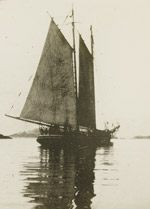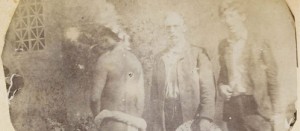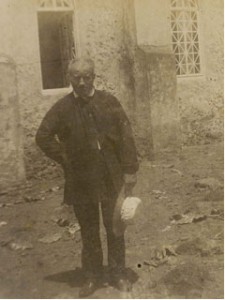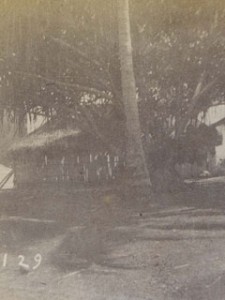The Casco was an elegant 95-feet, two-masted schooner: ‘a lovely craft to the eye, as she sat like a bird upon the water. Her saloon was fitted most luxuriously with silk and velvet’ (Graham Balfour, Life of Robert Louis Stevenson [London: Methuen, 1901], vol. 2, p. 37). It was hired from Dr. Merritt of San Francisco with Captain Albert H. Otis as skipper. Stevenson was accompanied by his wife, his mother, his stepson Lloyd Osbourne, and Valentine Roch, the maid.
Waiting for it to be fitted out, the Stevenson party stayed at the Occidental Hotel on Montgomery Street, San Francisco (7-26 June 1888).
They moved aboard on 26 June. And at 5 a.m. on 28 June 1888 the Casco passed through the Golden Gate and into the Pacific Ocean. RLS was never to return to North American again.

The first part of the cruise was among tropical islands of French Polynesia south of the Equator: the Marquesas, the Paumotas and Tahiti. Then they went north to Hawaii, where the cruise ended. The sailing lasted from June 1888 to January 1889 after which RLS stayed in Hawaii until June 1889.
Marquesas Islands
From San Francisco on 28 June the Casco sailed S.S.W. for three weeks to the Marquesas Islands, a group of volcanic islands (‘high islands’—with mountains), just south of the Equator and part of French Polynesia. They made their first landfall on 20 July 1888 when they arrived at the island of Nuka-Hiva, the largest of the Marquesas Islands.
This arrival is described in the first chapter of In the South Seas (1896): “The first experience can never be repeated. The first love, the first sunrise, the first South Sea island, are memories apart and touched a virginity of sense…” (Tusitala Edition, 1924, p. 4). In a letter to Sidney Colvin (28 July 1888) he says “The climate is delightful; and the harbour where we lie one of the loveliest spots imaginable”

(The Letters of Robert Louis Stevenson, ed. by Bradford A. Booth and Ernest Mehew, vol 6 [New Haven: Yale University Press, 1995], p. 206).
On 12 August, after three weeks based in Anaho Bay on Nuka-Hiva, they sailed round the eastern side of the island to Tai-o-hae, on the south side, the island’s largest settlement.
On 22 August, the Casco sailed from Nuka-Hiva, and on 23 August arrived at Hiva-oa, the largest of the south Marquesas group of islands. All the time, Stevenson was meeting chiefs, missionaries and other informants: collecting information for his ‘big book’ about the South Seas. Lloyd Osbourne was taking photographs that were intended for the same work (though these were never used). The Marquesas are described in Part I of In the South Seas.
Paumotus Islands
On 4 September 1888, the Casco sailed S.W. to the coral atolls (‘low islands’) of the Paumotus (also known as the Dangerous Archepelago and now called the Tuamotus). On 9 September Stevenson arrived at the largest of the atolls, Fakarava, in the western part of the archipelago, after difficult navigation through the many reefs and islands. The Paumotus are described in Part II of In the South Seas.
Tahiti
In the Paumutos, Stevenson caught a cold which worsened, so he decided to set off for somewhere with doctors. On 25 September the Casco sailed West and two days later arrived in Papeete, the administrative centre of Tahiti. After staying at the Hotel de France for a few days they moved to a rented house.
In Papeete RLS was ill for a few weeks, then in October 1888 he started work on finishing The Master of Ballantrae.

Feeling better, on 24 October he sailed round the more isolated S.E. part lobe of the island (Tahiti Iti): to Taravao on the isthmus that joins the two parts of the island. After four days, on 28 October 1888, he sailed to the village of Tautira, on northern coast of Tahiti Iti Here he became seriously ill and so stayed there slowly recovering for the rest of the year, working on The Master of Ballantrae and collecting material about the Tahitian songs, legends and traditions.
It was an enjoyable period for RLS after he recovered. He made friends with Ori a Ori (also known as Teriitera), the sub-chief of the village . RLS called Tautira ‘The Garden of the World’, ‘mere Heaven’, ‘the most beautiful spot, and its people the most amiable, I have ever found’ (The Letters of Robert Louis Stevenson, ed. by Bradford A. Booth and Ernest Mehew, vol 6 [New Haven: Yale University Press, 1995], p. 221, 239).
RLS briefly visited Papara on the south coast of the main island from 24 to 26 November. Here he collected more songs and legends from Chief Tati for his ‘big book’.

Captain Otis on 30 November found that the mainmast of the Casco had dry rot so had to go back to Papeete to be refitted.
On 25 December the Casco set sail for Honolulu, where they arrived a month later on 24 January after a difficult voyage. Shortly afterwards, RLS decided to send the Casco back to San Francisco. He stayed on the Hawaiian islands for another five months before starting the Equator cruise in June 1889.
By Richard Dury
Image 1 courtesy of Capital Collections. Image 2 courtesy of Capital Collections. Image 3 courtesy of Capital Collections. Image 4 courtesy of Capital Collections. Image 5 courtesy of Capital Collections.
